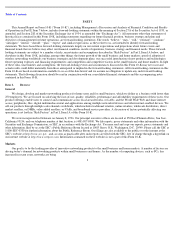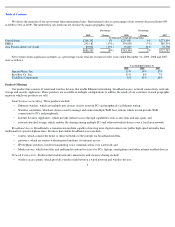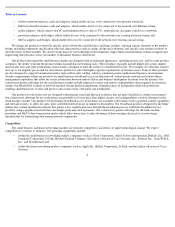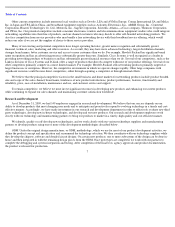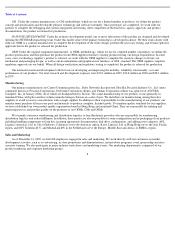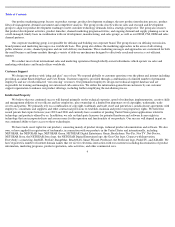Netgear 2009 Annual Report Download - page 15
Download and view the complete annual report
Please find page 15 of the 2009 Netgear annual report below. You can navigate through the pages in the report by either clicking on the pages listed below, or by using the keyword search tool below to find specific information within the annual report.
Table of Contents
Our business is subject to the risks of international operations.
We derive a significant portion of our revenue from international operations. As a result, our financial condition and operating results
could be significantly affected by risks associated with international activities, including economic and labor conditions, political instability, tax
laws, and changes in the value of the U.S. dollar versus local currencies. Margins on sales of our products in foreign countries, and on sales of
products that include components obtained from foreign suppliers, could be materially adversely affected by foreign currency exchange rate
fluctuations and by international trade regulations. Additionally, certain foreign countries have complex regulatory requirements as conditions of
doing business. Meeting these requirements may increase our operating expenses as we expand internationally.
We obtain several key components from limited or sole sources, and if these sources fail to satisfy our supply requirements, we may lose
sales and experience increased component costs.
Any shortage or delay in the supply of key product components would harm our ability to meet scheduled product deliveries. Many of the
semiconductors used in our products are specifically designed for use in our products and are obtained from sole source suppliers on a purchase
order basis. In addition, some components that are used in all our products are obtained from limited sources. These components include
connector jacks, plastic casings and physical layer transceivers. We also obtain switching fabric semiconductors, which are used in our Ethernet
switches and internet gateway products, and wireless local area network chipsets, which are used in all of our wireless products, from a limited
number of suppliers. Semiconductor suppliers have experienced and continue to experience component shortages themselves, such as with
substrates used in manufacturing chipsets, which in turn adversely impact our ability to procure semiconductors from them. Our third party
manufacturers generally purchase these components on our behalf on a purchase order basis, and we do not have any contractual commitments
or guaranteed supply arrangements with our suppliers. If demand for a specific component increases, we may not be able to obtain an adequate
number of that component in a timely manner. In addition, if worldwide demand for the components increases significantly, the availability of
these components could be limited. Further, our suppliers may experience financial or other difficulties as a result of uncertain and weak
worldwide economic conditions. It could be difficult, costly and time consuming to obtain alternative sources for these components, or to change
product designs to make use of alternative components. In addition, difficulties in transitioning from an existing supplier to a new supplier could
create delays in component availability that would have a significant impact on our ability to fulfill orders for our products.
If we are unable to obtain a sufficient supply of components, or if we experience any interruption in the supply of components, our product
shipments could be reduced or delayed. Component shortages and delays affect our ability to meet scheduled product deliveries, damage our
brand and reputation in the market, and cause us to lose market share. For example, component shortages in the fourth quarter of 2009 limited
our ability to supply all the worldwide demand for our products and our revenue was affected.
If we do not effectively manage our sales channel inventory and product mix, we may incur costs associated with excess inventory, or
lose sales from having too few products.
If we are unable to properly monitor, control and manage our sales channel inventory and maintain an appropriate level and mix of
products with our wholesale distributors and within our sales channels, we may incur increased and unexpected costs associated with this
inventory. We generally allow wholesale distributors and traditional retailers to return a limited amount of our products in exchange for other
products. Under our price protection policy, if we reduce the list price of a product, we are often required to issue a credit in an amount equal to
the reduction for each of the products held in inventory by our wholesale distributors and retailers. If our wholesale distributors and retailers are
unable to sell their inventory in a timely manner, we might lower the price of the products, or these parties may exchange the products for newer
products. Also, during the transition from an existing product to a new replacement product, we must accurately predict the demand for the
existing and the new product.
13


